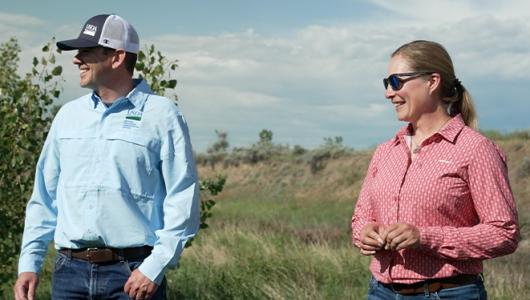The Conservation Stewardship Program (CSP) is sometimes misunderstood. It is perceived by some as complicated or not for small operations, and neither of those perceptions is true. CSP is designed to help you take your existing conservation efforts on your operation to the next higher level while maintaining your current ones. It’s supposed to help you add to what you’re already doing, either by enhancing your current practices or adding new ones.
The Natural Resources Conservation Service (NRCS) works one-on-one with you to develop a conservation plan under CSP to implement these additions or enhancements and help strengthen your operation.
Under CSP, you receive annual payments to help you maintain your existing conservation efforts and enhance them using new conservation practices or activities. CSP contracts last five years, with the opportunity to compete for a contract renewal if you successfully fulfill the initial contract and agree to achieve additional conservation objectives.
As Deputy Chief for Programs at NRCS, I’ve had the chance to work with producers, as well as NRCS employees, explaining how CSP works and how the program can enhance conservation and strengthen an agricultural operation.
As I said, though, CSP is often misunderstood, so here are a few “myths” about the program that I want to dispel.

Myth #1: The deadline to apply for CSP in my state has already passed, so I don’t need to think about applying until next year.
Don’t wait to apply! We accept applications year-round, but funding decisions are made locally at specific times and that “ranking date” may be coming up soon in your area. If we already have your application, it will be considered at the next ranking date. Plus, if you start planning now, you will be ready for application ranking dates as they approach. See program application ranking dates for all states at https://www.nrcs.usda.gov/ranking-dates.
Myth #2: Enrolling land in CSP is complicated and time-consuming.
If you have a farm and tract number (available from USDA’s Farm Service Agency) and have kept good farm records, you’re already well on your way. You just need to complete a three-page NRCS-CPA-1200 form, see Applications and Forms. You can even complete this form online if you create a farmers.gov account at https://www.farmers.gov/account.
Myth #3: My farm is too small to qualify for CSP.
CSP has no minimum acreage requirement. Regardless of operation size, NRCS provides a minimum annual payment to ensure participants can comply with the terms of the contract. Starting in fiscal year 2024, the minimum annual payment was set at $4,000 for all CSP contracts. You can contact your local field office, and they can let you know if there have been any updates.
Myth #4: I have an active EQIP contract, so I can’t apply for CSP.
Eligible land may be enrolled in both EQIP and CSP programs at the same time as long as the programs don’t cover the same practices on the same footprint. You may not be compensated for the same practices at the same time under both programs (no double dipping).
Myth #5: The new per-acre payment rates for CSP haven’t been set yet.
NRCS updates the per-acre payment rates each year. The current payment rates for cropland, pastureland, rangeland, forestland, and associated agricultural land can be accessed on the NRCS payment schedules website at: https://www.nrcs.usda.gov/getting-assistance/payment-schedules.
Myth #6: I’m not listed as the operator of record on my farmland, so I can’t apply for CSP.
To be an eligible applicant for CSP, you can be the operator, owner, or other tenant of an agricultural operation in the Farm Service Agency farm record management system.
Myth #7: The CSP commitment of five years makes me ineligible because some of my leases are for shorter time periods.
NRCS understands that lease arrangements between tenants and landowners vary in length and may get renewed annually or at some other interval. As the producer, you know your operation best, and which leases will most likely be renewed for the next five years. As such, you may enroll these lands with confidence and not change the current lease arrangements you have with the landowners. If you do happen to lose a lease on land under a CSP contract, then notify NRCS immediately, and we can work with you to update your contract. In addition, if you have some leased land that you are not certain will be renewed for the entire contract period, you may leave that land out of your application.
Myth #8: EQIP pays more than CSP.
Not necessarily. We can calculate your payments to help you decide which program makes more sense for you. CSP contract payments are based on two components: Existing Activity Payments (EAP) and Enhancement Payments. EAPs are intended to help producers maintain their existing level of stewardship and are provided for each land use in the operation in which new enhancement activities will be adopted. Enhancement Payments are made to implement additional conservation activities to help producers achieve their higher stewardship goals. In addition, there is a minimum annual payment of $4,000 for all CSP contracts, regardless of operation size. It’s also important to remember that no conservation program is designed to pay every bill.
Myth #9: I’m farming some new land that I can’t enroll until my current five-year CSP contract expires.
Additional land can be enrolled in any year if it’s not already covered by an existing CSP contract.
Myth #10: I’ve already addressed all my resource concerns, so I don’t need CSP.
CSP pays participants for existing conservation measures as well as for new ones. Even if resource concerns are met, you may select enhancements to take your land management to the next level. NRCS staff can visit and conduct an assessment on available options for you.
Karen Woodrich is Deputy Chief for Programs with NRCS.
***This blog was updated on May 14, 2025.


